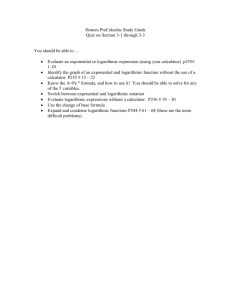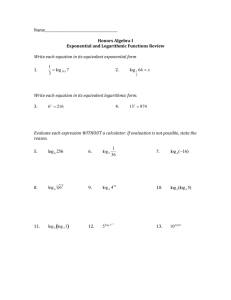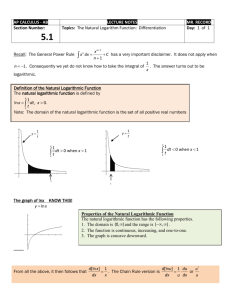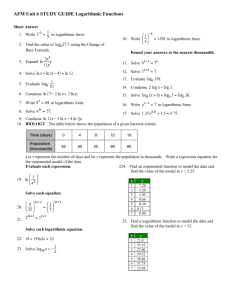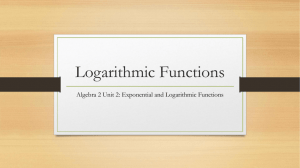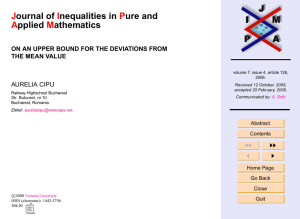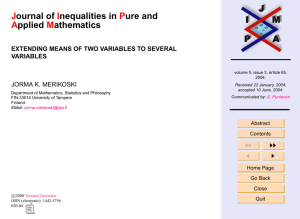J I P A
advertisement
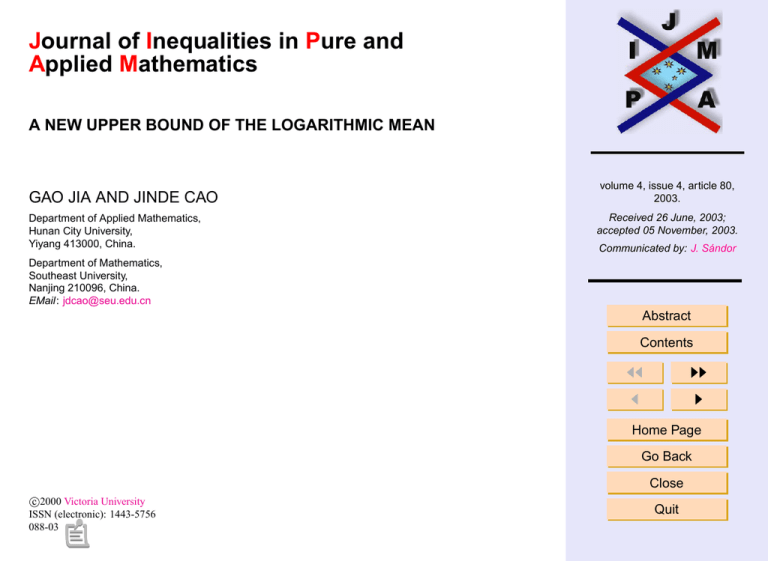
Journal of Inequalities in Pure and Applied Mathematics A NEW UPPER BOUND OF THE LOGARITHMIC MEAN GAO JIA AND JINDE CAO Department of Applied Mathematics, Hunan City University, Yiyang 413000, China. volume 4, issue 4, article 80, 2003. Received 26 June, 2003; accepted 05 November, 2003. Communicated by: J. Sándor Department of Mathematics, Southeast University, Nanjing 210096, China. EMail: jdcao@seu.edu.cn Abstract Contents JJ J II I Home Page Go Back Close c 2000 Victoria University ISSN (electronic): 1443-5756 088-03 Quit Abstract Let a and b be positive numbers with a 6= b. The inequalities about the logarithmicmean L(a, b) < Hp (a, b) < Mq (a, b) are obtained, where p ≥ 12 and q ≥ 23 p. We would point out that p = q = 13 are the best constants such that above inequalities hold. 1 2 and A New Upper Bound of the Logarithmic Mean 2000 Mathematics Subject Classification: 26D15, 26D10 Key words: Logarithmic mean; Power mean; Heron mean; Best constant. Gao Jia and Jinde Cao This work was supported by the Natural Science Foundation of China(60373067 and 19771048), the Natural Science Foundation of Jiangsu Province(BK2003053), QingLan Engineering Project of Jiangsu Province, the Foundation of Southeast University, Nanjing, China (XJ030714). Title Page Contents JJ J Contents 1 Introduction and Main Results . . . . . . . . . . . . . . . . . . . . . . . . . . 2 Proof of Theorem 1.1 . . . . . . . . . . . . . . . . . . . . . . . . . . . . . . . . . References 3 5 II I Go Back Close Quit Page 2 of 9 J. Ineq. Pure and Appl. Math. 4(4) Art. 80, 2003 http://jipam.vu.edu.au 1. Introduction and Main Results The aim of this paper is to establish a new upper bound for the logarithmic mean. Let a and b be positive numbers with a 6= b, p > 0, q > 0. The logarithmic mean is defined as b−a L(a, b) = , log b − log a The power mean is defined by q 1 a + bq q Mq (a, b) = , 2 A New Upper Bound of the Logarithmic Mean Gao Jia and Jinde Cao and the Heron mean is defined as Hp (a, b) = ap + (ab)p/2 + bp 3 Title Page p1 . Contents There are many important results concerning L(a, b), Mp (a, b) and Hq (a, b). The well known Lin Tong-Po inequality (see [1]) is stated as L(a, b) < M 1 (a, b). (1.1) Close L(a, b) < M 1 (a, b) < H1 (a, b). Quit 2 In [1], Kuang J. C. summarized and stated the interpolation inequalities (1.3) L(a, b) < M 1 (a, b) < M 1 (a, b) < H1 (a, b) < M 2 (a, b). 3 2 II I Go Back 3 In [2], Yang Z.H. obtained the inequalities (1.2) JJ J 3 Page 3 of 9 J. Ineq. Pure and Appl. Math. 4(4) Art. 80, 2003 http://jipam.vu.edu.au In this paper, we further improve the upper bound of the logarithmic mean and obtain the following theorem: Theorem 1.1. Let p ≥ 12 , q ≥ 23 p, and a, b be positive numbers with a 6= b. We then have (1.4) L(a, b) < Hp (a, b) < Mq (a, b). Furthermore, p = 21 , q = 2 3 are the best constants for (1.4). A New Upper Bound of the Logarithmic Mean Gao Jia and Jinde Cao Title Page Contents JJ J II I Go Back Close Quit Page 4 of 9 J. Ineq. Pure and Appl. Math. 4(4) Art. 80, 2003 http://jipam.vu.edu.au 2. Proof of Theorem 1.1 In this section, there are two goals: the first is to state and prove some fundamental lemmas. The second is to prove our main result by virtue of these lemmas. Lemma 2.1. ([3], [4]). Suppose a and b are fixed positive numbers with a 6= b. For p > 0, then Hp (a, b) and Mp (a, b) are strictly monotone increasing functions with respect to p. Lemma 2.2. Let x > 1. Then x−1 < log x (2.1) 1 1 x2 + x4 + 1 3 A New Upper Bound of the Logarithmic Mean !2 . Gao Jia and Jinde Cao 1 Proof. Taking t = x 4 , where x > 1, it is easy to see that inequality (2.1) is equivalent to 1 t4 − 1 < (t2 + t + 1)2 . 4 log t 9 (2.2) Define the function f (t) = (2.3) 4 t4 − 1 log t − 2 . 9 (t + t + 1)2 Calculating the derivative for f (t), we get 4 4t3 (t2 + t + 1) − 2(t4 − 1)(2t + 1) f (t) = − 9t (t2 + t + 1)3 2(t − 1)4 (2t2 + 5t + 2) = . 9t(t2 + t + 1)3 0 Title Page Contents JJ J II I Go Back Close Quit Page 5 of 9 J. Ineq. Pure and Appl. Math. 4(4) Art. 80, 2003 http://jipam.vu.edu.au 1 Since t = x 4 > 1, we find that f 0 (t) > 0. Obviously, f 0 (1) = 0. So f (t) > 0 for t > 1. i.e. (2.1) holds. Lemma 2.3. Let x > 1, then the following inequality holds !2 !3 1 1 1 2 4 3 x +x +1 x +1 (2.4) < . 3 2 1 Proof. Taking t = x 12 , where x > 1, it is easy to see that inequality (2.4) is equivalent to A New Upper Bound of the Logarithmic Mean 9(t4 + 1)3 > 8(t6 + t3 + 1)2 . Gao Jia and Jinde Cao (2.5) Define a function g(t) as Title Page 4 3 6 3 2 g(t) = 9(t + 1) − 8(t + t + 1) . Factorizing g(t), we obtain g(t) = (t − 1)4 (1 + 4t + 10t2 + 4t3 − 2t4 + 4t5 + 10t6 + 4t7 + t8 ) = (t − 1)4 ((t4 − 1)2 + 4t + 10t2 + 4t3 + 4t5 + 10t6 + 4t7 ). Contents JJ J II I Go Back Close The proof is completed. Proof of Theorem 1.1. We first prove, for p = 12 , q = 13 , that (1.4) is true. In fact, since a > 0, b > 0 and a 6= b, there is no harm in supposing b > a. If we take x = ab , using Lemma 2.2 and Lemma 2.3, we have Quit Page 6 of 9 J. Ineq. Pure and Appl. Math. 4(4) Art. 80, 2003 (2.6) L(a, b) < H 1 (a, b) < M 1 (a, b). 2 3 http://jipam.vu.edu.au For q ≥ 23 p, there is the known result ([1]) (2.7) Hp (a, b) < Mq (a, b), (a 6= b). Using Lemma 2.1, combining (2.6) and (2.7), we can conclude that 1 2 L(a, b) < H 1 (a, b) < Hp (a, b) < Mq (a, b), p ≥ , q ≥ p . 2 2 3 Next, we prove that p = 21 and q = 13 are the best constants for (1.4). Suppose we know that the following inequalities A New Upper Bound of the Logarithmic Mean Gao Jia and Jinde Cao (2.8) L(x, 1) < Hp (x, 1) < Mq (x, 1), hold for any x > 1. There is no harm in supposing 1 < x ≤ 2. (In fact, if n < x ≤ n + 1, we can take t = x − n, where n is a positive integer.) Taking t = x − 1, applying Taylor’s Theorem to the functions L(x, 1), Hp (x, 1) and Mq (x, 1), we have (2.9) 1 1 L(x, 1) = L(t + 1, 1) = 1 + t − t2 + · · · , 2 12 Title Page Contents JJ J II I Go Back Close (2.10) (2.11) 2p − 3 2 1 Hp (x, 1) = Hp (t + 1, 1) = 1 + t + t + ··· , 2 24 1 q−1 2 Mq (x, 1) = Mq (t + 1, 1) = 1 + t + t + ··· , 2 8 Quit Page 7 of 9 J. Ineq. Pure and Appl. Math. 4(4) Art. 80, 2003 http://jipam.vu.edu.au With simple manipulations (2.9), (2.10) and (2.11), together with (2.8), yield − (2.12) 1 2p − 3 q−1 ≤ ≤ . 12 24 8 From (2.12), it immediately follows that 2 1 p ≥ , and q ≥ p. 2 3 We then have, by virtue of Lemma 2.1, that p = constants for (1.4). 1 2 and q = 1 3 are the best Remark 2.1. It√is easy to see that the best lower bound of the logarithmic mean is H0 (a, b) = ab, namely H0 = G, the geometric mean. In addition, using Lemma 2.1, combining (1.4), (2.7), (2.8) and the related results in [1], we derive the following graceful inequalities √ ab < L(a, b) < H 1 (a, b) < M 1 (a, b) < Mα (a, b) < Hβ (a, b) < Mγ (a, b), 2 where 1 3 <α< log 2 β, log 3 3 γ ≥ 23 β, β > log 3 . 3 log 2 Acknowledgment 1. The authors would like to thank the referees for their valuable suggestions. A New Upper Bound of the Logarithmic Mean Gao Jia and Jinde Cao Title Page Contents JJ J II I Go Back Close Quit Page 8 of 9 J. Ineq. Pure and Appl. Math. 4(4) Art. 80, 2003 http://jipam.vu.edu.au References [1] J.C. KUANG, Applied Inequalities, Hunan Eduation Press, 2nd. Ed., 1993. [2] Z.H. YANG, The exponent means and the logarithmic means, Mathematics in Practice and Theory, 4 (1987), 76–78. [3] B.F. BECKENBACH 1961. AND R. BELLMAN, Inequalities, Spring-Verlag, [4] G.H. HARDY, J.E. LITTLEWOOD bridge, 2nd Ed., 1952. AND G. PÓLYA, Inequalities, Cam- A New Upper Bound of the Logarithmic Mean Gao Jia and Jinde Cao Title Page Contents JJ J II I Go Back Close Quit Page 9 of 9 J. Ineq. Pure and Appl. Math. 4(4) Art. 80, 2003 http://jipam.vu.edu.au

